
Tradescantia is a genus of 85 species of herbaceous perennial wildflowers in the family Commelinaceae, native to the Americas from southern Canada to northern Argentina, including the West Indies. Members of the genus are known by many common names, including inchplant, wandering jew, spiderwort, dayflower and trad.

Echinacea is a genus of herbaceous flowering plants in the daisy family. It has ten species, which are commonly called coneflowers. They are found only in eastern and central North America, where they grow in moist to dry prairies and open wooded areas. They have large, showy heads of composite flowers, blooming in summer. The generic name is derived from the Greek word ἐχῖνος, meaning "hedgehog", due to the spiny central disk. These flowering plants and their parts have different uses. Some species are cultivated in gardens for their showy flowers. Two of the species, E. tennesseensis and E. laevigata, were formerly listed in the United States as endangered species; E. tennesseensis has been delisted due to recovery and E. laevigata is now listed as threatened.

Ptelea trifoliata, commonly known as common hoptree, wafer ash, stinking ash, and skunk bush, is a species of flowering plant in the citrus family (Rutaceae). It is native to North America, where it is found in Canada, Mexico, and the United States. It is a deciduous shrub or tree, with alternate, trifoliate leaves.

Scaffold web spiders or cave cobweb spiders (Nesticidae) are a family of araneomorph spiders closely allied with tangle-web spiders (Theridiidae). Like the Theridiidae, these spiders have a comb of serrated bristles on the hind tarsi that are used to pull silk bands from the spinnerets. Nesticidae contains 16 genera and about 300 species, many of which are associated with caves or overhangs. The genus Nesticus is the type for the family and is found throughout the world. The related Eidmannella has speciated considerably in Texas caves and includes some extremely localized species that are considered threatened. One species, Eidmannella pallida, is found in caves and under overhangs, but also in agricultural fields and other habitats away from such restricted areas. The genus Carpathonesticus is found in central Eurasia.

The cave swallow is a medium-sized, squarish-tailed swallow belonging to the same genus as the more familiar and widespread cliff swallow of North America. The cave swallow, also native to the Americas, nests and roosts primarily in caves and sinkholes.

Apamea sordens, the rustic shoulder-knot or bordered apamea, is a moth of the family Noctuidae. The species was first described by Johann Siegfried Hufnagel in 1766. It is distributed throughout Europe, east across the Palearctic to Central Asia and to China and Japan. It also occurs in North America.
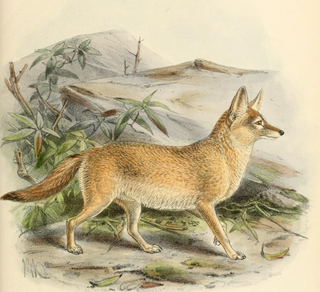
The pale fox is a species of fox found in the band of African Sahel from Senegal in the west to Sudan in the east. It is one of the least studied of all canid species, in part due to its remote habitat and its sandy coat that blends in well with the desert-like terrain. The pale fox is distinguished by its light-colored fur and oversized ears, which enable it to excel in camouflage and survival in harsh environments.
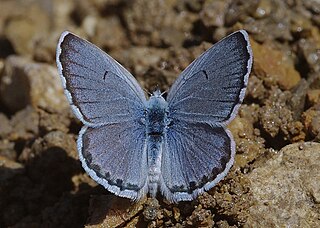
Pseudophilotes vicrama, the eastern baton blue, is a small butterfly found in Asia, east to Tian Shan and parts of China, west to the Balkans, Turkey, eastern Europe to southern Finland. It belongs to the lycaenids or blues family. The species was first described by Frederic Moore in 1865.

The many-striped canastero is a species of passerine bird in the Furnariinae subfamily of the ovenbird family Furnariidae. It is found in Colombia, Ecuador, and Peru.

The jacky winter is a small grey-brown robin found commonly throughout Australia and also in Papua New Guinea. The jacky winter acquired its name due to rapid and strong vocalisations, which sound like jacky-jacky winter-winter. Their call is also often referred to as sounding like peter-peter-peter. Its habitats include open woodlands and farmlands.

The least honeyguide is a small species of bird in the family Indicatoridae. It is found in sub-Saharan Africa.

Actinemys is a small genus of turtles in the family Emydidae. The genus is endemic to the west coast of North America. The genus contains two species.
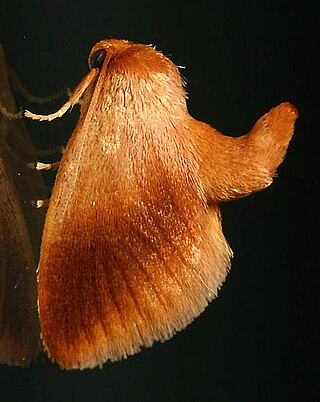
The warm-chevroned moth is a moth of the family Limacodidae. It is found from Nova Scotia west and south to Manitoba, Missouri and Mississippi. There is also a record from South Carolina.

Aloeides pallida, the giant copper, is a butterfly of the family Lycaenidae. It is found in South Africa.
Trischistognatha yepezi is a moth in the family Crambidae. It is found in Venezuela and Costa Rica.
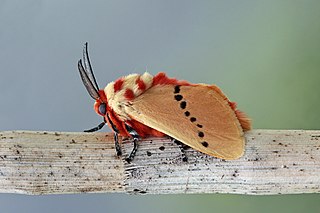
Trosia nigropunctigera, commonly known as the rosy ermine moth, is a lepidopteran in the family Megalopygidae native to the Neotropics. These moths have a wingspan of 45-60mm, and are distributed across Costa Rica, Panama, Colombia, Venezuela, Guyana, Ecuador and Peru. The species was first described by David Stephen Fletcher in 1982.

Tortricidia is a genus of moths of the family Limacodidae. It was described by Alpheus Spring Packard in 1864.
Eremochrysa pallida is a species of green lacewing in the family Chrysopidae. It is found in North America.
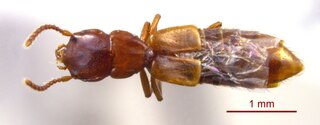
Eleusis pallida is a species of unmargined rove beetle in the family Staphylinidae. It is found in North America.

Eleusis is a genus of unmargined rove beetles in the family Staphylinidae. There are about 10 described species in Eleusis.
















